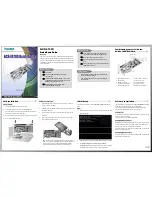
Commissioning
4.4 Basic settings in the operating system
SIMATIC RF650M mobile reader
24
Operating Instructions, 04/2015, C79000-G8976-C404-01
NID Link Watchdog
With this applet, you can put a service into operation for monitoring connectivity via wireless
LAN (WLAN) or by USB. This service informs the user about an interruption of the
connection by sounding a warning signal and displaying a corresponding message on the
screen. As soon as a functional communications channel is available again, the message
window disappears from the screen and a connected signal sounds.
The purpose of this service is to improve the user-friendliness of the device particularly in the
WLAN environment where an interruption of the connection can occur daily. One reason for
this may be that the device is outside the range of the WLAN coverage or there is a longer
bad signal transmission. The user therefore receives information about an interruption of the
WLAN connection that may be difficult to recognize when there are other problems. This
allows suitable measures to be taken immediately after interruption of the WLAN connection.
The Link Watchdog service can only be used when the computer can be reached via the
cable backbone network of the WLAN infrastructure. The monitoring does not require any
special software on this computer. Only its IP address and the TCP port number for sending
"polls" need to be set in the applet. Polling does, however, require an open TCP port on the
computer. In addition to this, the computer must also react to TCP connection initiations. An
alternative to the end device for monitoring connectivity is a Web server running on the
computer.
NOTICE
Blocking by firewall and NAT device
If there is a firewall, a NAT device or both between the RF650M mobile reader and the
computer sending the polls, it is possible that the service for monitoring the NAT connection
does not work if no changes to the configuration are made on the NAT device and on the
firewall.
NID Menu
The NID Menu is a support application that helps you with your work. With the NID Menu, a
number of applications can be selected and added to a menu displayed via the desktop. The
NID Menu provides the option of completely blocking access to the Windows desktop when
necessary.
In the "Settings" tab, you can specify the content of the NID Menu, add new programs and
delete programs that are not required. You can change the order in which the programs in
the NID Menu are displayed using the "Up" and "Down" buttons.
Select the "Enable Startup Menu" check box to start the NID Menu after starting up. You can
also specify an "Unlock Password" that is required by the user to exit the NID Menu. With
these settings, following startup the user only has access to the NID Menu and the programs
it contains.
You can add new programs with the "Add" button. The "New Entry" tab is opened. In this
tab, you can search for and name the exe file for starting the program. You can also assign
arguments for the program and specify a picture for the start button. The picture must exist in
png format and can have a maximum size of 48 x 48 pixels.
















































